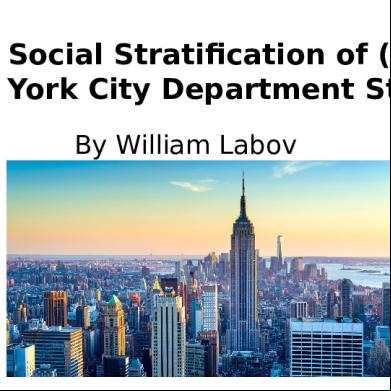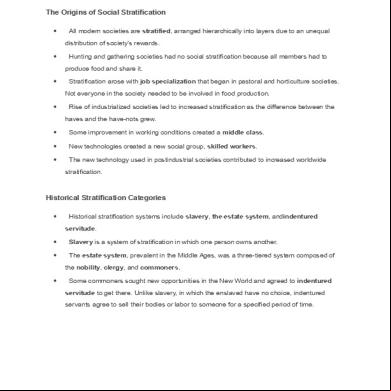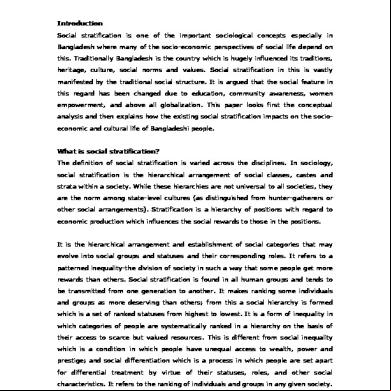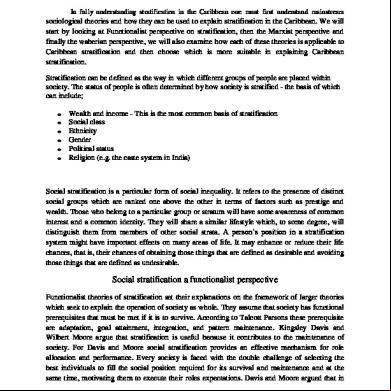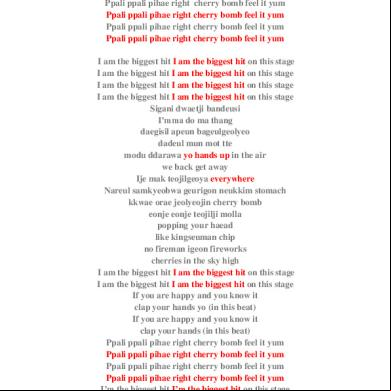The Social Stratification Of (r) In Nyc Department Stores 6e2l3p
This document was ed by and they confirmed that they have the permission to share it. If you are author or own the copyright of this book, please report to us by using this report form. Report 3i3n4
Overview 26281t
& View The Social Stratification Of (r) In Nyc Department Stores as PDF for free.
More details 6y5l6z
- Words: 754
- Pages: 14
The Social Stratification of (r) in New York City Department Stores By William Labov
How to gather data? • One classical methodological problem one encounters in the study of language in its social context: • The means used to gather the data interfere with the data to be gathered. • Individual tape-recorded interview: monitored & controlled in response to the presence of an outside observer • One solution: study subject in his own natural social context – interacting with his family or peer group (Labov et al, 1968). • Another solution: observe the public use of language in everyday life apart from any interview situation • This study: systematic use of rapid & anonymous observations in a study of the sociolinguistic structure of the speech community
Preliminary Studies • An extensive series of preliminary investigations was carried out: 70 individual interviews and many anonymous observations in public places • These led to the definition of (r), as a phonological variable, in postvocalic position in car, card, four, fourth, etc. • This variable appeared to be sensitive to any measure of social or stylistic stratification. • On the basis of the exploratory interviews: it seemed possible to carry out an empirical test of two general notions: 1-(r) is a social differentiator in all levels of NYC speech 2-the rapid & anonymous speech events could be used as the basis of a systematic study of language.
Definition of Social Stratification • Bernard Barber (1957): social stratification is the product of social differentiation & social evaluation • This implies that -the normal workings of society have produced systematic differences between certain institutions or people -these differentiated forms have been ranked in status or prestige by general agreement
General Hypothesis & How to Test It • If any two subgroups of NYC speakers are ranked in a scale of social stratification, then they will be ranked in the same order by their differential use of (r). • Test1: comparing occupational groups, one of the most important indexes of social stratification • Test2: finding a subtle case of stratification within a single occupational group: the sales people of 3 large department stores in Manhattan, from the top, middle, & bottom of the price & fashion scale
The Differential Ranking of the Three Stores • Their locations are important: Saks Fifth Avenue (high fashion shopping district) Macy's (near garment district along with middle range stores) S. Klein • Their advertising & price policies are clearly stratified. • The physical plant of the stores also serve to differentiate them. • The principle stratifying effect upon the employees is
The Method • The interviewer approached the informant in the role of a customer asking for directions to a department, located on the fourth floor Interviewer: 'Excuse me, where are the women's shoes?’ Informant: 'Fourth floor.’ Interviewer: 'Excuse me?’ Informant: 'Fourth floor’ spoken in careful style under emphatic stress • Independent variables: the store – floor within the store – sex – age – occupation – race – foreign or regional accent • Dependent variable: the use of (r) in four occurrences: Causal: fourth floor (preconsonantal + final position) Emphatic: fourth floor
The Method • (r-1) for each plainly constricted value of the variable • (r-0) for unconstricted schwa, lengthened vowel, or no representation • d for doubtful cases or partial constriction
Overall Stratification of (r) • Results showed clear & consistent stratification of (r) in the 3 stores • All informants were divided into 3 categories: all (r-1): those whose records show only (r-1) & no (r-0) some (r-1): those whose records show at least one (r-1) & one (r-0) no (r-1): those whose records showed only (r-0)
Overall Stratification of (r)
• There is a considerable difference between Macy's & Klein at each position, but the difference between Macy's and Saks varies. • In emphatic pronunciation of the final (r), Macy's employees come very close to the mark set by Saks. • Saks employees have more security in a linguistic sense.
Overall Stratification of (r)
• The table shows the number of instances obtained for each of the four positions of (r) for each store. • The number of occurrences in the 2nd pronunciation of four is considerably reduced, because of some speakers’ tendency to answer a 2nd time, 'Fourth.’
Overall Stratification of (r)
• The pattern of differential ranking in the use of (r) is preserved in this subgroup of complete responses • Omission of the final 'floor’ by some respondents was not a factor in this pattern.
Thank you
How to gather data? • One classical methodological problem one encounters in the study of language in its social context: • The means used to gather the data interfere with the data to be gathered. • Individual tape-recorded interview: monitored & controlled in response to the presence of an outside observer • One solution: study subject in his own natural social context – interacting with his family or peer group (Labov et al, 1968). • Another solution: observe the public use of language in everyday life apart from any interview situation • This study: systematic use of rapid & anonymous observations in a study of the sociolinguistic structure of the speech community
Preliminary Studies • An extensive series of preliminary investigations was carried out: 70 individual interviews and many anonymous observations in public places • These led to the definition of (r), as a phonological variable, in postvocalic position in car, card, four, fourth, etc. • This variable appeared to be sensitive to any measure of social or stylistic stratification. • On the basis of the exploratory interviews: it seemed possible to carry out an empirical test of two general notions: 1-(r) is a social differentiator in all levels of NYC speech 2-the rapid & anonymous speech events could be used as the basis of a systematic study of language.
Definition of Social Stratification • Bernard Barber (1957): social stratification is the product of social differentiation & social evaluation • This implies that -the normal workings of society have produced systematic differences between certain institutions or people -these differentiated forms have been ranked in status or prestige by general agreement
General Hypothesis & How to Test It • If any two subgroups of NYC speakers are ranked in a scale of social stratification, then they will be ranked in the same order by their differential use of (r). • Test1: comparing occupational groups, one of the most important indexes of social stratification • Test2: finding a subtle case of stratification within a single occupational group: the sales people of 3 large department stores in Manhattan, from the top, middle, & bottom of the price & fashion scale
The Differential Ranking of the Three Stores • Their locations are important: Saks Fifth Avenue (high fashion shopping district) Macy's (near garment district along with middle range stores) S. Klein • Their advertising & price policies are clearly stratified. • The physical plant of the stores also serve to differentiate them. • The principle stratifying effect upon the employees is
The Method • The interviewer approached the informant in the role of a customer asking for directions to a department, located on the fourth floor Interviewer: 'Excuse me, where are the women's shoes?’ Informant: 'Fourth floor.’ Interviewer: 'Excuse me?’ Informant: 'Fourth floor’ spoken in careful style under emphatic stress • Independent variables: the store – floor within the store – sex – age – occupation – race – foreign or regional accent • Dependent variable: the use of (r) in four occurrences: Causal: fourth floor (preconsonantal + final position) Emphatic: fourth floor
The Method • (r-1) for each plainly constricted value of the variable • (r-0) for unconstricted schwa, lengthened vowel, or no representation • d for doubtful cases or partial constriction
Overall Stratification of (r) • Results showed clear & consistent stratification of (r) in the 3 stores • All informants were divided into 3 categories: all (r-1): those whose records show only (r-1) & no (r-0) some (r-1): those whose records show at least one (r-1) & one (r-0) no (r-1): those whose records showed only (r-0)
Overall Stratification of (r)
• There is a considerable difference between Macy's & Klein at each position, but the difference between Macy's and Saks varies. • In emphatic pronunciation of the final (r), Macy's employees come very close to the mark set by Saks. • Saks employees have more security in a linguistic sense.
Overall Stratification of (r)
• The table shows the number of instances obtained for each of the four positions of (r) for each store. • The number of occurrences in the 2nd pronunciation of four is considerably reduced, because of some speakers’ tendency to answer a 2nd time, 'Fourth.’
Overall Stratification of (r)
• The pattern of differential ranking in the use of (r) is preserved in this subgroup of complete responses • Omission of the final 'floor’ by some respondents was not a factor in this pattern.
Thank you
